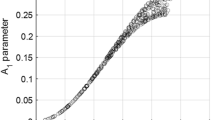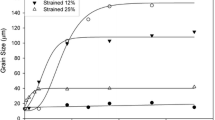Abstract
The effect of initial orientation of samples on the magnetic properties and texture of ultrathin grain-oriented steel strips produced of them has been studied. In a number of cases, the samples with a larger initial deviation from the ideal (110)[001] orientation demonstrate a higher level of magnetic properties (if considering the total set of characteristics) in comparison with the samples with a small initial deviation. For the samples with a larger initial deviation, the final magnitudes of the magnetic induction obtained after the treatment exceed its initial magnitudes. Therefore, for producing an ultrathin grain-oriented electrical steel with high properties, a material with a scattered orientation of grains relative to the ideal (110)[001] orientation can be used.
Similar content being viewed by others
References
I. B. Kekalo and B. A. Samarin, Physical Metallurgy of Precision Alloys. Alloys with Special Magnetic Properties (Metallurgiya, Moscow, 1989) [in Russian].
K.I. Arai and K. Ishiyama, “Rolled Texture and Magnetic Properties of 3% Silicon Steel,” J. Appl. Phys. 64(10), 5352–5354 (1988).
C. H. Han and J. C. Shin, “Rolled Textures and Magnetic Properties of Regular Grain Oriented 3% Silicon Steel with Very Low Thickness,” Textures Microstruct. 14–18, 915–920 (1991).
N. Abe, Y. Ushigami, M. Iwasaki, and T. Nozawa, “Magnetic Properties and Domain Structures in Primary Recrystallized Thin-Gauge Si-Fe with Orientation Near (110)[001],” IEEE Trans. Magn. 30(4), 1360–1363 (1994).
G. Xiuhua, Q. Kemin, and Q. Chunlin, “Magnetic Properties of Grain Oriented Ultra-Thin Silicon Steel Sheets Processed by Conventional Rolling and Cross Shear Rolling,” Mater. Sci. Eng., A 430(1), 138–141 (2006).
N. H. Heo, J. Y. Soh, J. M. Oh, and S. B. Kim, “Influence of Cold-Rolling Texture and Heating Rate on {110}-001-Development in Inhibitor-Free 3% Si-Fe Sheets,” J. Magn. Magn. Mater. 320(20), 635–637 (2008).
V. A. Zaikova, I. E. Startseva, and B. N. Filippov, Domain Structure and Magnetic Properties of Electrotechnical Steels (Nauka, Moscow, 1992) [in Russian].
Y. Ushigami, Y. Okazaki, N. Abe, T. Kumano, M. Kikuchi, and T. Inokuchi, “Magnetic Properties of Thin Gauge 3% Si-Fe with {110}-001-Orientation,” J. Mater. Eng. 4(4), 435–440 (1995).
B. K. Sokolov, V. V. Gubernatorov, Yu. N. Dragoshanskii, et al., “Local Laser Treatment of an Extremely Thin Strip of Anisotropic Electrical Steel,” Fiz. Met. Metalloved. 75(5), 36–42 (1993) [Phys. Met. Metallogr. 75 (5), 486–490 (1993)].
C. G. Dunn, “Cold-Rolled and Primary Recrystallization Textures in Cold-Rolled Single Crystals of Silicon Iron,” Acta Metall. 2(3), 173–183 (1954).
H. Hu, “The Formation of (110)[001] Recrystallization Texture in Cold-Rolled and Annealed (110)[001] Crystal of Silicon-Iron,” Acta Metall. 8(2), 124–126 (1960).
T. Taoka, E. Furubayashi, and S. Takeuchi, “Formation of Cold-Rolled Texture and Recrystallized Texture in Single Crystals of 3% Silicon Iron. Part I,” Trans. Iron Steel Inst. Jpn. 6(7), 201–232 (1966).
T. Taoka, E. Furubayashi, and S. Takeuchi, “Formation of Cold-Rolled Texture and Recrystallized Texture in Single Crystals of 3% Silicon Iron. Part II,” Trans. Nat. Res. Inst. Met. 9(4), 187–207 (1967).
Yu. S. Avramov and G. Naumann, “Formation of the Initial Recrystallization Texture in (110) Single Crystal of Transformer Steel Rolled in Different Directions,” Fiz. Met. Metalloved. 24(6), 1042–1049 (1967).
D. Dorner, S. Zaefferer, and D. Raabe, “Retention of the Goss Orientation between Microbands during Cold Rolling of an Fe-3% Si Single Crystal,” Acta Mater. 55(7), 2519–2530 (2007).
M. A. Shtremel’, Strength of Alloys, Part 2: Deformation (MISiS, Moscow, 1999) [in Russian].
Ya. D. Vishnyakov, A. A. Babareko, S. A. Vladimirov, and I. V. Egiz, Theory of Texture Formation in Metals and Alloys (Nauka, Moscow, 1979) [in Russian].
M. Holscher, D. Raabe, and K. Lucke, “Relationship between Rolling Textures and Shear Textures in FCC and BCC. Metals,” Acta Metall. Mater. 42(3), 879–886 (1994).
Author information
Authors and Affiliations
Additional information
Original Russian Text © M.L. Lobanov, A.A. Redikul’tsev, G.M. Rusakov, I.V. Kagan, O.V. Pervushina, 2011, published in Fizika Metallov i Metallovedenie, 2011, Vol. 111, No. 5, pp. 502–509.
Rights and permissions
About this article
Cite this article
Lobanov, M.L., Redikul’tsev, A.A., Rusakov, G.M. et al. Effect of the grain orientation in the material used for the preparation of an ultrathin electrical steel on its texture and magnetic properties. Phys. Metals Metallogr. 111, 479–486 (2011). https://doi.org/10.1134/S0031918X11040089
Received:
Published:
Issue Date:
DOI: https://doi.org/10.1134/S0031918X11040089




